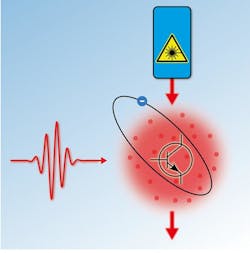Optical transistor enables 20X single-photon amplification for all-optical data processing
With the help of an ultracold quantum gas, scientists at the Max Planck Institute for Quantum Optics (MPQ; Garching, Germany) achieved a twentyfold amplification of single-photon signals.
RELATED ARTICLE: Max Planck's single-photon switch bring quantum information processing closer
Data transmission over long distances usually uses optical techniques via optical fibers to ensure high-speed transmission combined with low power dissipation of the signal. All-optical processing goes one step further with optical transistors and optical logic gates. For quantum information it would be optimal to store information in faint light pulses that—at the ultimate limit—contain a single photon only. A team led by professor Gerhard Rempe, leader of the Quantum Dynamics Division and director at the Max Planck Institute of Quantum Optics, has now made a kind of optical transistor using a cloud of ultracold rubidium atoms. With this new device the team observed a twentyfold amplification of signal variations at the one-photon level.
In the case of an optical transistor the input signal is a weak light pulse (gate pulse) that modifies the transparency of a "medium" for a second pulse (target pulse). In the experiment at MPQ, the medium consists of a cloud of about 150,000 rubidium atoms, kept in an optical dipole trap that is generated by two crossed laser beams. At temperatures of about 0.30 micro-Kelvin (just above absolute zero), the cloud can be held in place for several seconds. The effect of electromagnetically induced transparency (EIT), in which a control laser modifies the interaction of a faint light pulse with the medium, makes the atomic cloud transparent for light pulses of certain frequencies.
The atomic cloud is irradiated with two light pulses of the same color (795 nm) separated in time by two microseconds. The first gate pulse is extremely weak, containing less than one photon on average. In combination with the applied control laser it brings one atom in the cloud into a highly excited Rydberg state. As in this state one of the outer electrons orbits at a large distance from the nucleus, this single excitation has a long-range effect: by the mere presence of the Rydberg atom the corresponding energy levels of all other atoms in the cloud are slightly shifted. When the second target pulse hits the cloud, its color does not match the EIT conditions anymore and the target pulse is blocked by the atoms.
A couple of months ago the team demonstrated that it is possible to switch the transmission properties of a cloud of rubidium atoms with single photons (see https://journals.aps.org/prl/issues/113/5). However, this effect was achieved under severe limitations concerning duration as well as intensity of the target pulses.
"In the present experiment we have changed a few things, most importantly, we use control lasers with different wavelengths for gate and target pulses," says Stephan Dürr, leading scientist. "That way we avoid that the target pulse couples to the Rydberg excitation and retrieves the gate pulse, even for long durations of the target pulse."
Also, different Rydberg states were chosen that give rise to a Förster resonance at which the Rydberg atoms interact with each other even more strongly than they usually would. “The Förster-resonance enhances the effect of the Rydberg blockade which is the true mechanism that prevents the target pulse from traversing the atomic cloud,” explains Daniel Tiarks, doctoral candidate for the experiment. “Furthermore, with the principle quantum numbers of the chosen Rydberg states we get a smaller effect of self-blockade of the photons in the target pulse, another obstruction that we had to deal with in our previous experiment. With all these measures we were able to increase the duration of the target pulse by two orders of magnitude, up to 200 microseconds.”
By comparing the intensities of the outgoing target pulses with and without a preceding gate pulse (a single photon), the reduction of the target signal was determined. The team says the effect should make it possible in principle to cascade such transistors in order to solve complex computational tasks.
SOURCE: Max Planck Institute for Quantum Optics;http://www.mpq.mpg.de/cms/mpq/en/news/press/14_07_28.html

Gail Overton | Senior Editor (2004-2020)
Gail has more than 30 years of engineering, marketing, product management, and editorial experience in the photonics and optical communications industry. Before joining the staff at Laser Focus World in 2004, she held many product management and product marketing roles in the fiber-optics industry, most notably at Hughes (El Segundo, CA), GTE Labs (Waltham, MA), Corning (Corning, NY), Photon Kinetics (Beaverton, OR), and Newport Corporation (Irvine, CA). During her marketing career, Gail published articles in WDM Solutions and Sensors magazine and traveled internationally to conduct product and sales training. Gail received her BS degree in physics, with an emphasis in optics, from San Diego State University in San Diego, CA in May 1986.
